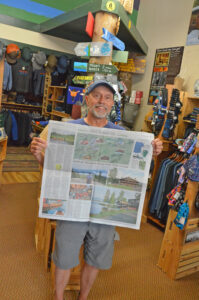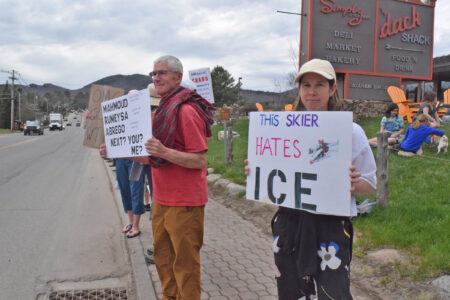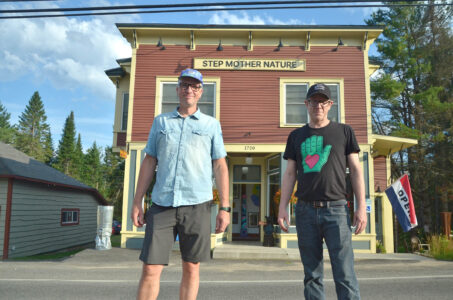‘We gave it a shot’
More village officials agree with cancellation of 2nd Carnival fireworks

The Saranac Lake Winter Carnival Court and other royalty pose in front of the Ice Palace before the fireworks Saturday night. From left are (front row) Queen Nancy Heath, Kelsey Leeret, Forrest Monroe and King Joe Szwed, (back row) Chamberlain James Carpenter, Cedar Young, Peter Fogarty, Andrew Fogarty, Dellice Chase, Colter Cheney-Seymour, Rhett Darrah, Naila Cecunjanin, Gwen Mader and Archbishop Paul Giroux. (Enterprise photo — Lou Reuter)
SARANAC LAKE — Public health and police officials in this village agree with Monday’s decision by the Winter Carnival Committee and village manager to cancel the closing fireworks show, scheduled for next Saturday. They said the rules of their plan at the first show last Saturday were not followed, creating a potential infraction of New York Forward COVID-19 rules they do not want to repeat.
“We gave it a shot. I think it was a solid plan,” Saranac Lake Public Health Officer Ray Scollin said. “But Carnival is just too well known. Too many people come.”
The plan involved closing River Street to traffic and letting people park their cars in the road to watch the fireworks. People were asked not to gather on foot, or to socially distance and wear masks if they did. Scollin said this was where the trouble was.
He said he spoke with Winter Carnival Committee Director Jeff Branch and village Manager John Sweeney Monday, and they based their decision on eyewitness reports from Carnival volunteers, police officers and village Department of Public Works employees. He said they had hoped for better adherence, but that the public did not stay within the guidelines they had set.
“Not one of us said we should move on with the (second) fireworks,” Scollin said. “Every one of us did not like what we saw on Saturday. I expected Winter Carnival might give some pushback, but no.”
He said they worried the congregations of firework watchers on foot violated state gathering rules and would again on Saturday.
“We knew we’d get a few people on the street, but we thought it’d be minimal. It wasn’t,” Scollin said. “The congregation of people were in larger numbers than we had hoped for, and there were some people who were not wearing masks, and a lot of those people went out to the bars afterwards.
“I went around and looked at license plates, and they were from all over the place: Pennsylvania, New Jersey, Vermont.”
Scollin said risk management is about mitigating, not eliminating risk, but he was not willing to keep adding risk. He said the plan they created was good. If not, he said another authority would have told them beforehand. But he said the rules were not followed.
Scollin spoke with Franklin County Public Health Director Kathleen Strack Tuesday and said she understood and appreciated their decision. He also notified Essex County Director of Public Health Linda Beers.
Village Mayor Clyde Rabideau said he spoke with Branch and respects their decision.
“I think they made a very reasonable decision based upon their experience,” Rabideau said. “They really tried hard to bring some sort of Carnival experience to our village, and they did a phenomenal job under the circumstances. … They kept the tradition alive to the best of their ability.”
Village police Chief James Joyce said the road closure for parking — a new operation for his department — was successful, and that organizers fit a surprising amount of cars on River Street. There were no injuries or collisions in the process, he said.
Joyce said cars leaving were doing celebratory honks, not traffic honks.
He said when he reminded people to stay in their cars, they complied.
“I just had to explain to them that if there was an issue with this event, that could endanger next week’s event — which, in fact, it did,” Joyce said.
He, too, said the problem was people gathering in large groups. His officers reported two groups of around 100 people each, and he saw a steady flow of people walking down himself.
Joyce said requests for pedestrians to social distance were not successful. He said his officers were focused on preventing collisions between cars, or between cars and pedestrians, and couldn’t break up the crowds on foot.
“The police officers kind of had to keep their eyes on the intersections and the people in cars rather than leaving their posts to do what they know is not going to be effective,” Joyce said.




